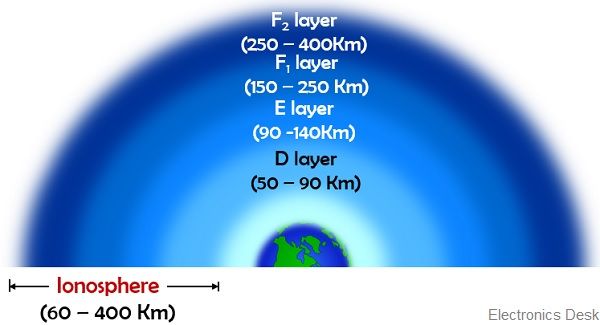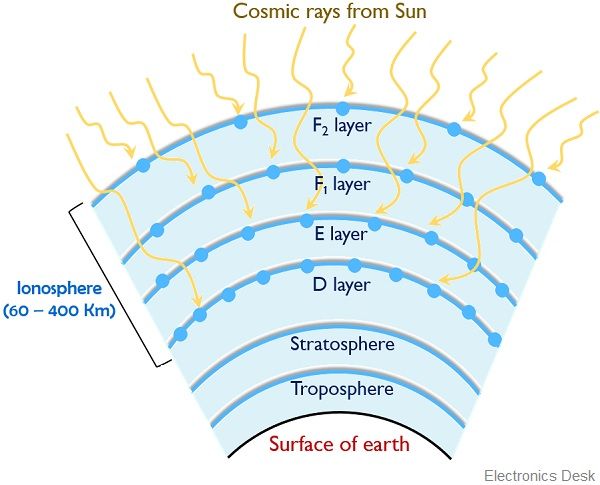Definition: A type of radio wave communication in which the electromagnetic wave propagates due to the reflection mechanism of the ionospheric layer of the atmosphere is known as sky wave propagation. Due to propagation through the ionosphere, it is also known as ionospheric wave propagation.
The permissible frequency range in the case of sky wave propagation lies between 3 MHz to 30 MHz.
Basically the electromagnetic waves in the range of 3 to 30 MHz get reflected by the ionosphere. However, the signals with frequency beyond 30 MHz despite undergoing reflection get penetrated. So, due to this reason, sky wave propagation is suitable only for this particular range of frequency.
Content: Sky Wave Propagation
Why do we need Sky Wave Propagation?
In the previous article, we have discussed ground wave propagation in which the electromagnetic wave propagates through the surface of the earth. We know that ground wave propagation is usually suitable for the transmission of low-frequency electromagnetic signals (usually up to 2 or 3 MHz).
Also, another major disadvantage associated with ground wave propagation is that it is suitable only for short-range operation. This is so because the induced wave in ground wave propagation causes attenuation of the propagated signal. Therefore, in order to transmit the signal with the least attenuation, it is preferred that the signal is transmitted only to short ranges, in the case of ground wave propagation.
So, these two factors: low-frequency signal transmission and short distance propagation are the two major disadvantages associated with ground wave propagation. And in order to overcome these two disadvantages, sky wave propagation is used.
It allows the propagation of electromagnetic waves of higher frequency from one end to another at a larger distance than ground wave propagation. And it does so by reflections of the wave from the ionosphere. Thus sometimes referred to as ionospheric wave propagation.
Structure of Ionosphere
We know that the ionosphere is present in the upper atmospheric region and is composed of ionized layers. Generally, the ionosphere consists of 4 different layers namely D, E, F1, and F2. These layers are present at different heights from the surface of the earth. Basically the ionosphere is said to be extended from 60 to 400 Km from the surface of the earth.
The figure below represents the structure of the ionosphere:

Each layer has a different concentration of atoms in a way that the ionized layer which is present nearer to the surface of the earth has the highest number of neutral atoms. While the middle layer has moderate concentration and the outermost layer consists of a very less number of neutral atoms.
It is clearly shown in the above figure that the D layer is present at around 50 to 90 km above the surface of the earth. While E, F1, and F2 are present at 90 to 140 km, 150 to 250 km, and 250 to 400 km respectively above the surface of the earth.
What is Sky Wave Propagation?
Till now we have discussed that electromagnetic waves propagate through the ionospheric region in order to get transmitted over larger distances. Let us now understand, how sky wave propagation takes place.
We have recently discussed that the ionosphere is composed of 4 different layers and each layer consists of a different number of atoms. The outmost layer has the lowest number of atoms while the innermost layer of the ionosphere is highly dense. The reason behind this is that the atmosphere of earth is denser towards its surface and becomes rarer on proceeding upwards.
We are already aware of the fact that the sun emits powerful cosmic rays. So, due to less number of neutral atoms in the outermost layer, most of the cosmic rays penetrate the inner surface of the atmosphere without even interacting with the atoms present there. However, as the inner layer is slightly denser than the outer one so here interaction between cosmic rays and atoms takes place.
Moreover, this interaction between cosmic rays and the atoms increases tremendously in the E layer of the ionosphere, as this layer has a greater number of atoms. But on penetrating to such a level inside the earth’s atmosphere, the intensity of the cosmic rays reduces to a large extent. Hence very few cosmic rays interact with the innermost layer of the ionosphere although this layer is denser than other layers. This is clearly shown in the figure given below:
So, when cosmic rays interact with the atoms present in the ionospheric layers then electrons are emitted from the valence shell of the atom. Thus ionization takes place. And as interaction is higher in the case of middle layers of the atmosphere, therefore, ionization will be higher in that layer itself.
Thus it holds the maximum number of charged particles.
- Now, whenever an electromagnetic signal is transmitted from an antenna then it suffers reflection from the ionospheric layer and comes back to the surface of the earth and is received by the receiving antenna.
We know that electromagnetic waves are composed of electric and magnetic fields. Also, the charged particles present in the layers of the ionosphere have their own electric field. So, when EMW is allowed to be propagated through the earth’s atmosphere then the field of the EMW and the charged particles interact with each other. And this leads to cause reflection of the electromagnetic wave by the atmosphere.
More simply we can say this as TIR taking place in the atmosphere.
- We know that when light propagates from a denser to a rarer medium with an angle equal to or greater than a critical angle then it gets reflected back towards the same medium. This is referred as Total Internal Reflection.
In a similar way when the transmitting antenna transmits the electromagnetic wave with a certain angle (equal or greater than critical angle) then due to ionization on the earth’s atmosphere it gets reflected back towards the surface of the earth. This causes the reception of the reflected signals by the receiving antenna.

It is to be noted here that the field in the atmospheric layer must be sufficiently large so that it can allow reflection of the electromagnetic waves through it. This is so because it may be possible that a high-frequency wave may not be reflected by the lower region of the ionosphere.
However, with upward movement, even the high-frequency wave will get reflected due to a higher degree of ionization.
- So, we can say this as a low-frequency wave is reflected by the lower layer and the high-frequency wave is reflected by the upper layer. But beyond a certain permissible frequency (generally 30 MHz) the wave despite getting reflected penetrates the atmospheric region and is lost.
Hence sky wave propagation is suitable for the frequency range from 3MHz to 30 MHz. But for signal frequency greater than 30 MHz, space wave propagation is used. The critical frequency in the case of sky wave propagation is given as:
![]()
We know that frequency and wavelength are inversely proportional to each other and the higher the frequency lower will be the wavelength. Also, we are aware of the fact that a signal of a lower wavelength propagates a higher distance. Thus in sky wave propagation signal can be transmitted to a larger distance. In this way, sky wave propagation eliminates the disadvantages associated with ground wave propagation.
- An important factor of ionospheric wave propagation is – skip distance. And skip distance is defined as the minimum distance on the surface of the earth from where the signal is transmitted and the reflected signal from the ionosphere has been received.
It is given by:
 where,
where,
- h denotes the height where reflection occurred,
- fMUF represents the maximum usable frequency,
- fc denotes the critical frequency,
- Dskip is the skip distance.
Advantages of sky wave propagation
- It supports large distance propagation.
- The frequency range of operation is considerably high.
- Attenuation due to atmospheric conditions is less.
Disadvantages of sky wave propagation
- Long-distance propagation requires large-sized antennas.
- Due to the presence of the ionosphere near and far during night and day respectively there exist variation in signal transmission in day and night.
Applications
Sky wave propagation is widely used in mobile and satellite communications as it needs suitable atmospheric conditions.
nice notes
Well explained!
Is the frequency of the radio waves reflected by the ionosphere differ from the incident wave frequency?